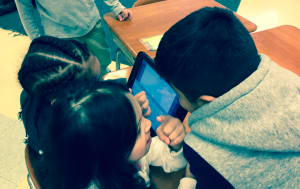
In my consulting role I have the opportunity to work with teams of teachers, administrators, and on occasion push into classrooms to work with students. Recently I’ve been working with K-2 teachers and students who are learning to craft digital stories on the iPad, using apps such as Book Creator, Scribble Press, GarageBand and iMovie. This initiative came about as the result of an eventual shift in curriculum away from an adopted (textbook/series-based) literacy program to one that is more project-based and technology-infused. A grant was written to obtain the iPads and to fulfill the grant, teachers are working with students to publish a variety of digital storytelling projects that demonstrate their creativity and ideas learned.
Each class has achieved a different level of proficiency using the apps and story publication. This is due to the varying age level and developmental level of students, for sure, but it’s also due to the mindset and willingness of the teacher to embrace this initiative and the resources she has been given.
So what did I see, and what have I seen through both my district coaching and principal roles, in classrooms where technology use has been embraced?
I see teachers as learners. I see teachers who:
- Make the time. They examine what they’re currently doing: the books they’re reading, the activities and projects students are completing, and they think: how can technology enhance and transform these projects? How can we change what we’re doing instead of add on one more thing?
- Have routines and procedures in place, especially for collaborative projects and times when teamwork is expected. Student roles are established and clearly defined. Management is evident, which in turn leads to students being able to lead, learn, resolve conflicts, and create in an environment with fewer distractions.
- Plan. Anyone who has ever tried to incorporate technology meaningfully into the classroom and who has tried to “wing it” knows it can be less than successful. Know the purpose. Use with intent. (And perhaps your students will unveil a purpose you perhaps never before considered…)
- Model. These teachers get hands on. They create! They’re not afraid to tinker, not only during their own professional learning sessions, but in front of a student audience, allowing them to observe what it’s like to try something new.
- Have high expectations for project performance. In my digital storytelling workshops I emphasize the importance of students making meaning, not just making media. Bernajean Porter is a key resource for anyone looking to ensure meaningful content and idea development through digital project work!
- Learn alongside students. It’s so encouraging as a coach to see a teacher who sits down with a student or a group of students and taps, swipes, creates, questions, and troubleshoots alongside his little learners.
- Showcase student work. One teacher in particular was so enthused with her students’ creations and couldn’t wait to have them share their projects with me. These teachers find a way to make sure their student voices are heard. Publishing to an authentic audience is a great way to do so. In addition, they utilized the sharing features from each app to publish to Google Drive and share with parents and families via links. Another group’s publications will be shared with local pediatricians’ offices as waiting room reading material!
- Embrace the noise. Learning is messy. Collaboration can be loud. Conflict resolution is a pretty intense process that rarely involves whispering. Movement to different learning spaces throughout the day is not the quietest of activities. Find ways to help your students thrive in the busiest of environments.
- Ask for help and actively seek out resources to learn more. Not every teacher I’ve worked with in a coaching capacity is comfortable asking for help. They’re very fixed in their methods and they have a very narrow focus: teach the written curriculum, the way it has traditionally been taught. When a teacher (or principal or coach) asks for help and embarks on a journey to learn more, see more, do more, think differently… kids win.
What am I missing? What do you see when working with innovative teachers and learners?

